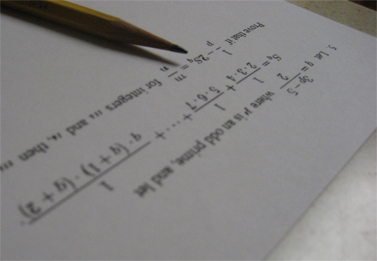 Students to take the USAMO and USAJMO tests
Students to take the USAMO and USAJMO tests
On April 8, it came as an announcement during math class. Nothing special—just a quick announcement in their respective math classes.
In those announcements, senior Kevin Shen and freshman Douglas Chen found out they qualified for the United States of America Math Olympiad while sophomore Barak Gila also learned he qualified for the United States of American Junior Math Olympiad.
Along with senior Lawrence Pan, Shen and Chen were three of the 282 USAMO qualifiers in the entire nation, while Gila was one of 222 USAJMO qualifiers. They were the only Olympiad qualifiers from MVHS.
The test
The USAMO and the USAJMO are national math tests administered annually in search for the most mathematically-competent high school students across the country. To qualify for either test, participants must take the American Mathematics Contest and the American Invitational Mathematics Examination. The scores of those two tests are combined into an index score out of 300, and students qualify for the USAMO or the USAJMO if they make a cutoff.
Unlike Gila and Shen, Chen was certain he had a high enough index score to qualify for the USAMO after taking the AIME. Even though he hadn’t learned of his official score yet, he believed it was a total of 216, well above this year’s index of 188 point.
As a result, the announcement that Chen qualified didn’t surprise him. “I wasn’t really that excited that I made it,” he said. “I was just kind of amazed that the index was so low.”
The lower index cutoff is a result of the harder AIME this year. Usually, that index is usually around 200.
A close call
It was that lower index that saved Shen from missing the cutoff. He squeezed through with an index score of 188.5, barely qualifying by only half a point. Still, advancing to take the USAMO was a big achievement for him. For his last three years at MVHS, Shen had tried to qualify for the USAMO, only to miss each year’s cutoff by about four points.
The same held true for Gila. Had he missed one more question on the AIME, he would not have advanced to take the USAJMO. Gila qualified for the USAJMO last year, so the close call worried him. “[It] would be kind of sad if I made it last year, allegedly got better at math, and then didn’t make it,” he said.
The next step
From here, the three qualifiers don’t believe they can pass to the next round to the Mathematical Olympiad Summer Program, which is accepting the top 50 USAMO scorers this year. According to Shen, his chance is one in 10 to the power of 10 to the power of 10—that’s a one with 10 billion zeroes after it.
To him, the reason is simple. “I think the USAMO’s good at actually making sure the best people get in,” Shen said, “and I’m not [one of] the best people.”
Unlike the AMC and the AIME, it is impossible to guess on questions on the USAMO or the USAJMO and get a right answer. While the AMC and the AIME have multiple choice and numerical answers, respectively, the USAMO and the USAJMO require answers in the form of proofs.
In order to prepare for the upcoming test, Chen said he would probably do some practice problems and read books on problem solving and higher level math. On the other hand, Gila and Shen won’t be preparing at all, because they believe studying for the USAJMO or the USAMO is pointless. The problem with practicing for the USAMO and the USAJMO is the length and the subjects of its problems.
“If I had a couple days to prepare, I could maybe do one question a day,” Gila said. “They’re on such esoteric stuff that it’s not like a math test, where you can do ten practice problems and then you’ll know what a parabola is.”
This year’s USAMO and USAJMO tests for FUHSD qualifiers will be administered at Lynbrook High School on Apr. 27 and 28.
Correction: Senior Lawrence Pan also qualified for the USAMO.








